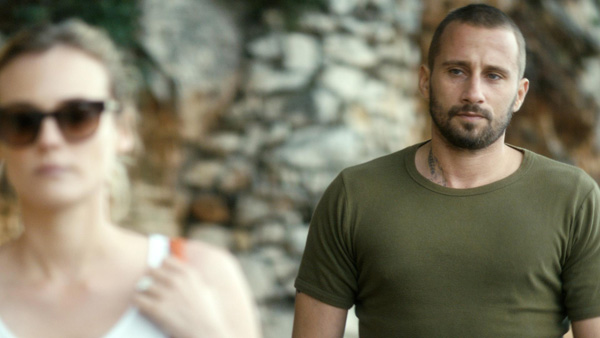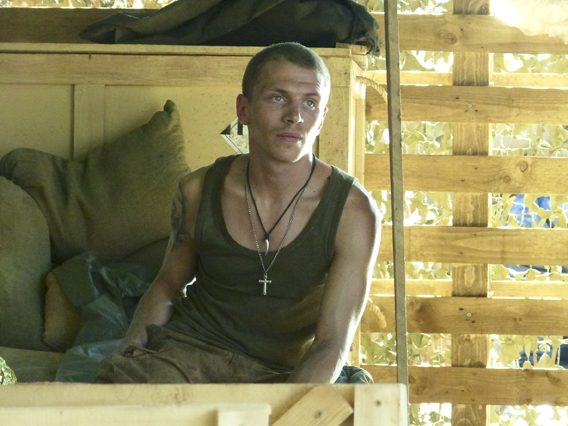The classy thriller Maryland singlehandedly jolted me from encroaching jet lag during my first full day at this year’s Cannes Film Festival. (The not-as-elegant English title is the blunter Disorder.) The screening was in the early afternoon after lunch, making it particularly sleep inducing. The movie’s initial slow pace and the often dreamy, bordering on hallucinatory atmosphere weren’t helping, either. But toward the 40-minute mark, a violent incident occurred, dispelling any drowsiness, and the rest of the film earned and kept my attention. Who needs coffee when you have two movie stars in roles for which they’re ideally suited?
This low-to-high burning two-hander is noteworthy in another way as well: It’s a 180-degree change of direction from filmmaker Alice Winocour’s fine first feature, Augustine, a period piece dealing with female repression and sexual expression set in an early 20th century asylum (which, by the way, starred Vincent Lindon, who went on to win best actor at Cannes this year for The Measure of a Man).
Now Winocour deliberately goes full-on genre, because “it is an area usually strictly reserved to men. Mostly likely my choice was also a way of saying that for female directors, ‘Everything is allowed’ today.” Though the emphasis is on suspense, the film is also driven by not-so-predictable characters. Its Hollywood pitch could be The Bodyguard meets American Sniper, without the latter’s quick cure of posttraumatic stress disorder (PSTD).
After serving in the French Special Forces in Afghanistan, Vincent (Matthias Schoenaerts) suffers from ear bleeds, hearing loss, and hallucinations, and his only employment options are low-paying jobs. Through a friend, he lands a gig as a security guard at the grand Gatsby-esque Cote d’Azur estate Maryland, owned by Lebanese tycoon Whalid (Percy Kemp), married to a blond Venus, Jessie (Diane Kruger). No one knows, or says, how Whalid made his fortune.
Vincent becomes the go-between for the audience through his voyeuristic point of view of the extravagant, nighttime poolside partying as he eavesdrops on the one percent of the one percent—shot in slo-mo, the revelers look even more orgiastic. Unlike the other two films mentioned earlier, Maryland departs from the straightforward path, with its distorted, ringing sound design and its heavy intrusive, thunderous bass: Vincent is still at war, at least mentally.
While Whalid is away on an international trip, Vincent is asked to look after Jessie and her young son. Up until this point, Jessie has barely looked at Vincent; he’s just part of the security detail. The first hint that they’re bound to acknowledge each other, sooner rather than later, is that they both lavish one-on-one attention on the family dog, Ghost, the most approachable living being on the entire estate.
On the first day of this assignment, Jessie briskly informs—commands is more like it—Vincent to drive her and the boy to the beach, and he fails to make a positive impression. On the way home, he suspects that another car is following them. Assuming that Vincent is driving recklessly, Jessie demands that he pull over so that she can take the wheel. Regarding what follows, I don’t think it’s spoiler to say that, ah, Vincent’s paranoia is well founded.
Until the midway point, Jessie has remained an aloof figure, barking out orders and reprimands. After what turns out to be a hair-raising outing from the beach, she returns home to find her husband’s study thoroughly ransacked. Then, in one lingering close-up, Winocour signals that now this is Kruger’s movie, too, and the audience begins to see Vincent from Jessie’s vantage: a wounded warrior who may also be dangerously unhinged.
Meanwhile, the rest of her staff is missing, and Vincent insists on turning the lights off to see who may be hiding outside on the estate grounds, transforming the invaded chateau into a haunted house. In the final act, Winocour goes back to basics; all it takes to produce a scare is for an intruder to lurk in the dark. In another old-school throwback, the early 1980s-esque electronic score is by French techno DJ Gesaffelstein, a musical progeny of Giorgio Moroder.
Sure, it’s formulaic and full of plot holes (just get out of the house already), but this popcorn movie is loaded with talent. It’s hard to find a more vulnerable, volatile, and sensitive actor working today than Schoenaerts, who has recently been seen in the English-language films The Drop and Far From the Madding Crowd. Vincent is tightly wound and physically rock hard, and yet no matter how much he rigidly tries to contain his emotions, they seep out. For a production of A Streetcar Named Desire, he’s your Stanley Kowalski: blatant, thuggish sexuality meets the vulnerable, raging man/child.
Diane Kruger has consistently given good performances in the past, even in merely decorative roles (Troy) or when she’s been miscast (the Serbian cab driver in Unknown). Here she exudes an elegance and coolness, not unlike Grace Kelly. (Audiences may wonder if she, and not Nicole Kidman, should have starred in the ill-fated Grace of Monaco.) Critically, both Winocour and Kruger know the secret to making audiences root for an untouchable ice princess: sooner or later, she has to thaw out. Jessie does so in a scene set late night in the undersieged mansion’s kitchen, which has become command central. She basks and beams in the very male attention of Vincent and another bodyguard. Jessie knows she’s being courted by two working-class guys who hang on her every word, and it’s probably been a long time since she has received so much adoring attention.
Remarkably, another French language film dealing with PSTD also screened at the festival in the International Critics’ Week sidebar, though in a manner unlike that of any war film I’ve seen. First-time writer/director Clément Cogitore gets inside the head of his lead character, an army captain, with very few tricks up his sleeve. At first, The Wakhan Front is as straightforward a war film as Lone Survivor. However, its overall subjective point of view draws its inspiration more from the theater of the absurd than Clint Eastwood. It becomes, dare I say, an existential trip. The far more evocative French title, Ni le ciel ni la terre (“Neither Heaven nor Earth”), hints at a particular state of limbo that entraps its on-screen soldiers.
Set near a remote mountainous Afghan province in 2014, the film focuses on a small force of about 12 men searching for signs of nearby Taliban activity in the valley. They are located on the border of tribal control, and relations between the French and the local shepherds are prickly. At the sight of boy and his goat trekking down a slope, the men have their guns at the ready.
Tension and distrust only increase. First, the camp’s canine mascot disappears. In short succession, two soldiers on night duty vanish, and there’s no sight of a struggle or of any intruders. As in Maryland, there’s a creeping sense of paranoia. Here, however, the lay of the land is murkier and more sinister, with a captain facing insubordination and losing the respect of his men. Viewers are on their own, too: there isn’t a central, clarifying perspective. Filmed in night vision, the search for the missing turns into an eerie, otherworldly trip into the unknown, and another strength is the strong cast, which includes Jérémie Renier and star-in-the-making Kévin Azaïs.
Sundance Select will distribute Maryland in the United States. Release date to be determined.








Leave A Comment